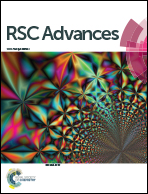Electrochemical reduction La(iii) on W and Mg electrodes: application to prepare Mg–La and Mg–Li–La alloys in LiCl–KCl melts
Abstract
The electrochemical behavior of La(III) ions was studied by different electrochemical measurements in LiCl–KCl–MgCl2 melts on a W electrode and in LiCl–KCl melts on an active Mg electrode at 873 K, respectively. Both on the W and Mg electrodes, three kinds of electrochemical signals corresponding to the formation/dissolution of Mg–La intermetallic compounds (Mg17La2, Mg3La and MgLa) were observed. Chronopotentiometry illustrated that, on the W electrode, the co-deposition of Mg(II), Li(I) and La(III) ions will be realized when the current density is more than −0.776 A cm−2. Potentiostatic electrolysis was employed to prepare Mg–La alloys on active magnesium electrodes, and galvanostatic electrolysis was carried out to synthesize Mg–Li–La alloys on the W electrodes. The phase composition, microstructure and micro-zone chemical analysis of the alloys were analyzed by XRD and SEM equipped with EDS analysis, respectively. The XRD patterns and SEM analysis indicate that the phase composition and alloy film thickness of Mg–La alloys can be regulated by the electrolytic potentials. The phase composition and crystalline structure of the Mg–Li–La alloys can be adjusted by adjusting the concentrations of MgCl2.


 Please wait while we load your content...
Please wait while we load your content...